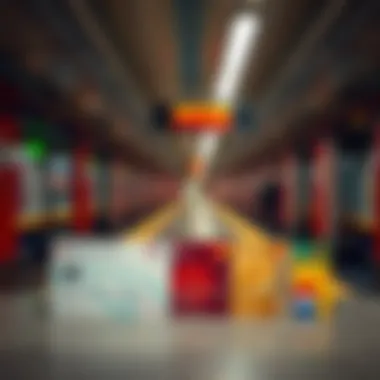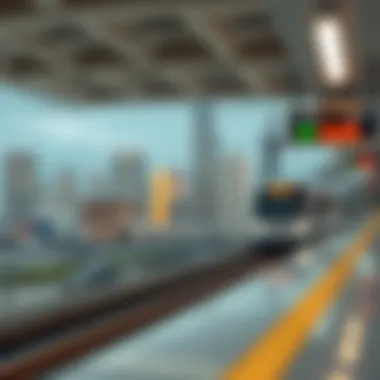Understanding Dubai Metro Fare Structure and Impact


Intro
Metro systems often serve as the backbone of urban transport, intertwining with local economies, lifestyle, and even property values. In Dubai, the metro network takes on added significance as it not only connects key areas within the city but also becomes a factor influencing real estate trends. Understanding the structure of metro fares is crucial for anyone looking to traverse the city or invest in its dynamic property market.
This article serves as a guide—delving into how metro fares are calculated, various payment methods available, and the broader impact these factors have on urban transportation and real estate trends in Dubai. We will also sketch the intricate relationship between transportation costs and property values, helping investors and buyers make informed decisions. As the world watches Dubai's skyline rise ever higher, comprehending the interconnectedness of metro fare structures and real estate is more important than ever.
Market Insights
Current Trends in Dubai Real Estate
The real estate market in Dubai continues to evolve at a brisk pace, marked by several key trends. The allure of investment opportunities is undeniable, particularly in areas surrounding metro stations. With the city's metro network expanding, areas that were once considered 'out of reach' are becoming more accessible, thus driving demand for properties nearby.
Recent statistics indicate a considerable increase in property values around metro stations over the last few years. For instance, neighborhoods like Dubai Marina and Downtown Dubai not only boast luxury residences but also enjoy excellent public transport connectivity, attracting both local and expatriate buyers. This trend underscores the vital connection between transit access and the desirability of real estate.
"Access to the metro is increasingly seen as a premium feature by buyers, elevating property values significantly."
Forecasting Future Market Changes
As we look ahead, the potential for future market changes remains dynamic. With ongoing infrastructural developments, including the expansion of the metro lines and the potential introduction of new services, the value of properties situated within close proximity to metro stations is likely to remain high.
Investors should also keep an eye on governmental initiatives aimed at boosting public transport. Projects like the Dubai 2040 Urban Master Plan highlight the growing focus on sustainable, efficient transportation, which in turn may increase property prices in well-connected locales.
Historical data and current trends point to an upward trajectory; knowledgeable investors can leverage this insight for strategic investments.
Investment Strategies
Tips for First-Time Investors
For those stepping into the Dubai real estate market for the first time, understanding the metro fare structure can offer significant advantages. Here are a few strategies to consider:
- Choose locations strategically: Focus on neighborhoods with metro accessibility. This will not only enhance your personal commuting experience but also attract future tenants or buyers.
- Research fare structure thoroughly: Knowing how fares are structured can help you anticipate costs for yourself or your tenants. This is particularly important when evaluating rental yields.
- Stay updated on upcoming developments: With new metro expansions planned, areas that are currently underdeveloped may see rapid price increases. Be proactive in identifying these opportunities.
Understanding ROI in Dubai Properties
Return on Investment (ROI) is a critical metric for any property investor. In Dubai, understanding how metro fares influence both occupancy rates and rental prices can directly affect ROI. Factors to take into account include:
- Accessibility: Proximity to metro lines can command higher rents and reduce vacancy rates.
- Market demand: Analyze how fare pricing affects commuter behavior. In general, if the cost of public transportation increases, it could deter some potential renters from high-end areas.
- Long-term plans: Engage with city planning resources, such as the Dubai Land Department or RTA, to understand how developments might influence fare pricing and, subsequently, rental demand.
By understanding these facets, investors can make informed choices, ultimately enhancing their investment portfolios in a city that's always on the move.
Preface to Dubai's Metro System
Dubai's Metro system is not just a means of transportation; it's a lifeline for many who navigate the bustling streets of this ever-evolving city. Launched in 2009, the metro has rapidly transformed how residents and tourists traverse through the urban landscape, providing a reliable alternative to traditional road travel.
One significant element that underscores the metro's importance is its impact on urban mobility. With the ever-growing population, Dubai's roads are often congested, leading to frustrating delays. The metro, by contrast, offers a swift and efficient option for commuters and visitors alike. Furthermore, it's seamlessly integrated into the city's layout, connecting key neighborhoods, business hubs, and major attractions, making it an essential component for those seeking to explore this vibrant metropolis.
Moreover, the metro serves as a model of innovation within urban transport systems close to the modern needs of a diverse population. The convenience of the metro encourages the use of public transport among expatriates and tourists. As they hop on the train, the experience reflects the cultural melting pot that Dubai represents.
Considerations about the fare structure become vital to understanding how this system operates. Next, we'll delve deeper into the intricacies that govern the metro fares. This exploration doesn't just highlight the costs associated with travel but also its link to the broader economic landscape, particularly concerning the real estate market. Investors, analysts, and buyers alike can benefit from grasping how transportation costs influence property values in the neighborhood sub-markets.
In summary, Dubai's Metro system encapsulates much more than its physical infrastructure. It represents innovation, urban planning, and economic strategy, making it an integral part of life in this dazzling city. Much awaits as we unravel the elements that form the central threads of the fare structure, providing insights that cater to the interests of all—be it the daily commuter or the astute investor.
Historical Context of the Metro
The historical backdrop of Dubai's metro system is not merely a tale of steel and concrete; it reflects the transformation of the city from a modest trading hub to a bustling metropolis, symbolizing progress, ambition, and the pursuit of modernity. This context is essential for understanding the metro's fare structure, as pricing reflects broader urban policies, economic strategies, and social considerations that have evolved over time.
Development Timeline
Dubai's metro project began its journey in the early 2000s. The urban planners envisioned a sophisticated transit system that would cater to the growing number of residents and tourists flooding into the city. The need for a structured and efficient transportation network was palpable. In 2005, the Roads and Transport Authority (RTA) was established with a clear mandate to oversee public transportation developments, specifically focusing on the metro.


The project broke ground in 2006. With a vision that aimed to connect key areas of the city and alleviate traffic congestion, the construction of the Red Line was launched. By 2009, the first segments opened for public use, providing residents with a reliable means to navigate through the city's busiest areas. This initial phase was completed amid rising construction costs, emphasizing the challenge of implementing large scale infrastructure projects.
Notably, in 2011, the Green Line was introduced, further expanding the metro network. A few years later, in 2016, the metro system offered an extension that included more stations, ensuring even broader coverage across Dubai’s diverse neighborhoods. The ongoing investments in the metro reflect an ambitious blueprint—one that integrates seamlessly into the fabric of the city’s urban planning initiatives.
Inauguration and Expansion
The inauguration of Dubai's metro was more than just the opening of a new transit option; it marked a significant milestone in the city's development narrative. When the Red Line opened its doors, it was celebrated not only as a transport solution but also as a testament to Dubai's aspirations for global recognition.
As the metro gained popularity, it propelled urban expansion, encouraging real estate developments around metro stations. This opened up lucrative opportunities for investors and enhanced accessibility for residents—making commuting to work or leisure not just efficient but also cost-effective.
The ongoing expansion in recent years signifies Dubai's commitment to improving urban mobility. With plans to extend the network even further, the metro system represents a critical element in addressing the challenges posed by a rapidly growing population and the associated influx of travelers. The fare structure, therefore, has been shaped through the lens of strategic urban expansion, aiming to balance accessibility with the costs of maintaining and upgrading the system.
As one looks toward the future, the historical context of Dubai's metro system not only provides insights into how fares have been constructed but also serves as a foundation for understanding the implications of transportation on real estate and urban policy in this dynamic city.
This historical perspective underlines the metro’s role as a driving force for urban innovation and economic development in Dubai.
Understanding Metro Fare Structure
Understanding the fare structure of Dubai's Metro system is crucial for anyone utilizing this efficient mode of transportation. With a blend of economic factors, urban planning insights, and multifaceted commuter behavior all at play, grasping the intricacies of fare calculation becomes more than just knowing how much a ticket costs. For investors and buyers, it's about comprehending how these fares influence property values and, subsequently, the urban landscape.
Metro fares are designed not just to cover operational costs, but also to encourage the use of public transport over individual cars. Thus, understanding this structure could reveal trends that might affect real estate investments. This section will delve into the specific components of fares and the various factors that influence how they are determined, painting a clear picture of what drives the cost of commuting through one of the fastest-growing cities in the world.
Base Fare Components
The base fare of Dubai Metro is not a simple flat-rate system. Rather, it is comprised of several components that together decide the final fare a passenger pays. First and foremost, the fare is calculated based on the zones a passenger traverses. Dubai Metro operates in a zone-based system, meaning the more zones you cross, the more you pay.
- Zone-Based Pricing: The city is divided into multiple zones, and fares vary depending on how many zones a passenger travels through. For instance, if a commuter travels from Burj Khalifa to the Dubai Marina, they are crossing several zones, which would lead to a higher fare compared to traveling within the same zone.
- Peak and Off-Peak Rates: Another essential aspect is the differentiation between peak and off-peak hours. Fares tend to be higher during peak hours when demand is greater, incentivizing commuters to travel during quieter times. This adjustment not only helps manage crowd levels in trains but also enhances the overall commuter experience.
- Weekend Pricing: On Fridays and Saturdays, the base fare might adjust slightly, adapting to the nature of weekend travel, which often includes more leisure trips.
The combination of these elements creates a fare structure that is both flexible and responsive to commuter needs.
Factors Influencing Fares
Several factors play into how fares are determined and adjusted. Understanding these can offer predictability for commuters and insights for investors looking at the bigger picture.
- Operational Costs: Ultimately, the cost of maintaining the Metro, including upkeep, staff salaries, and energy consumption, influences fare prices. As costs rise, the need to adjust fares becomes necessary to ensure the Metro’s sustainability.
- City Development Initiatives: As Dubai grows, so too do its transport needs. New developments and expansion of the Metro lines could result in fare adjustments that reflect the increased capacity or new zones that are added to the network. In this respect, the fare structure becomes a reflection of urbanistic shifts.
- Economic Conditions: Fluctuations in the economy, such as inflation rates or changes in public funding capabilities for transportation infrastructure, could also directly affect fare pricing. If the economy takes a downturn, maintaining lower fares becomes a challenge, thus impacting user behavior and demand.
Understanding these factors equips commuters and investors alike to anticipate changes and evaluate their consequences in real time.
In summary, recognizing the underlying components of metro fares and the relevant influencing factors is vital. This knowledge allows anyone who relies on the Dubai Metro to plan their travel with foresight, while also presenting critical information for those analyzing the transportation system's impact on local markets.
Payment Methods Available
The manners by which passengers can pay their metro fare is crucial to ensuring a smooth travel experience in Dubai’s extensive metro network. Understanding these payment options is essential for not just daily commuters, but also for investors and expatriates who are navigating the economic landscape of this vibrant city. Convenience and adaptability are central themes in this context, as the fare system reflects a blend of traditional practices and cutting-edge technology.
NOL Card Usage
The NOL card is the most widely accepted payment method for traveling on Dubai's metro. This stored value card serves as a beacon of efficiency, allowing users to effectively manage their metro journey without the hassle of cash transactions.
- Convenience: The card can be easily purchased from ticket vending machines, metro stations, and authorized retailers throughout the city. This accessibility makes it an attractive option for both residents and visitors. It’s as simple as swiping the card at the entry and exit points, saving time and avoiding long queues.
- Recharge Options: Users can recharge their cards through various means, including kiosks, mobile apps, and online platforms. This flexible recharging system gives cardholders control over their spending and helps them avoid unexpected expenses by keeping track of their usage.
- Discounts and Promotions: Regular users can benefit from discounts that apply when they utilize the NOL card. There’s a specific fare reduction on trips taken during certain times or days, which adds to the overall cost-effectiveness of using this card.
In the eyes of investors, the prominence of the NOL card exemplifies Dubai's commitment to modernizing its public transport infrastructure, enhancing both user experience and the value of property investments near metro stations.
Mobile Payment Options
The addition of mobile payment options to Dubai's metro system represents a leap forward in public transportation technology. Adopting a digital-first approach caters primarily to the tech-savvy population, which includes many expatriates. Here’s a closer look:
- Mobile Wallet Integration: Commuters can use popular mobile wallets such as Apple Pay, Samsung Pay, and Google Wallet to pay for their metro rides. This method not only speeds up the transaction but also aligns with the preferences of a younger demographic who favor cashless payments.
- Real-time Updates: Many mobile payment platforms offer users real-time updates on their fare balance, trip history, and upcoming promotions. This transparency fosters better budgeting for transportation expenses, which can significantly influence day-to-day living conditions and relocation decisions.
- Comfort and Safety: Using mobile payments can add a layer of safety for commuters. Carrying a card or a smartphone is often seen as more secure than having cash on hand, which could deter petty crime. For expatriates and tourists, the peace of mind that comes with such convenience can make a world of difference while exploring the city.
Utilizing mobile payments not only enhances the immediate travel experience but also hints at a more extensive shift towards digital economys in not just Dubai but the world. Integrating these methods into the metro fare system reflects a broader commitment to sustainability and efficiency in urban transport solutions.
The adoption of multiple payment methods empowers the user and provides significant convenience, contributing to increased ridership and positively influencing the socio-economic landscape of Dubai.


Metro Fare Discounts and Promotions
In any urban transit system, the availability of discounts and promotions can greatly influence commuter choices. Metro fare discounts and promotions in Dubai are critical components of the city’s strategy to encourage public transportation use and alleviate congestion on the roads. They offer financial relief, aiding both residents and visitors in navigating the transit network while managing their budgets. Understanding these incentives is key in grasping the full scope of the metro fare structure, especially for individuals and families who may use the metro frequently.
Student and Senior Citizen Discounts
Two significant groups that benefit immensely from metro fare discounts in Dubai are students and senior citizens.
- Students often juggle tight budgets while pursuing their studies. The metro's discounted fares provide a practical solution for commuting, especially for those attending educational institutions such as the University of Dubai or the American University in Dubai. By offering reduced fares to these young commuters, the metro system plays a vital role in making education more accessible.
- Senior citizens, on the other hand, have contributed to society over decades, and their travel needs should be accommodated with respect. The discounts available for elderly passengers can alleviate travel costs. This not only serves as a financial ease but also promotes a sense of inclusion and connection within the community, allowing seniors to maintain their independence and mobility.
As per the guidelines from the Roads and Transport Authority (RTA), eligible students and seniors are required to register for a NOL card, which then allows access to these discounted fares. This administrative step may seem minor but it greatly enhances the overall public transport experience for these users, fostering a culture of regular metro use without financial hindrance.
Seasonal Promotions
From time to time, Dubai’s metro system introduces seasonal promotions that entice both tourists and local commuters alike. These promotions often coincide with public holidays or major city events, aiming to boost ridership during peak times. For instance, during the Eid celebrations or the Dubai Shopping Festival, commuters might find limited-time fare reductions or enhanced services that make it easier to navigate the city.
Such promotions come with multiple benefits:
- Increased Accessibility: By lowering fares during these festive occasions, the metro system becomes more accessible, encouraging more residents and tourists to make use of public transport rather than opting for private vehicles.
- Cultural Integration: Seasonal promotions also align with the social fabric of Dubai, fostering a sense of community as people come together to celebrate. It reinforces public transport as a part of the city’s lifestyle.
- Raised Awareness: These promotions serve the dual purpose of encouraging existing users to utilize the metro more often and attracting new users who may have previously relied on other modes of transport.
Additionally, such campaigns are often publicized through various channels, ensuring that commuters are well-informed about the benefits on offer, which ultimately enhances metro utilization and generates a positive buzz about the city's transit options.
Promotions are not just about making transport cheaper; they play a critical role in promoting a culture of sustainability and shared resources among residents.
Comparative Analysis with Other Forms of Transport
A comparative analysis of metro fares and other forms of transport is essential in understanding the broader transportation ecosystem in Dubai. It allows for a nuanced perspective on the strengths and weaknesses of the metro system in relation to buses, taxis, and ride-hailing services. Understanding these dynamics provides insights not only for economical commuting but also for strategic investing and real estate decisions in a city experiencing rapid growth.
Bus Fares vs. Metro Fares
The fare structures of buses and the metro in Dubai reflect different operational models and target demographics.
- Base Fare Comparison: Metro fares often differ based on zones traveled and types of tickets used, while bus fares tend to operate on a flatter scale, making them more straightforward yet less versatile. For instance, a one-way metro ticket typically costs more than a bus fare for a similar distance. Investors looking to understand commuter preferences may find these patterns informative; they highlight how fare pricing can encourage or deter public transport use.
- Schedule and Frequency: Buses generally have a wider coverage area and can reach neighborhoods that the metro does not. However, metro trains provide faster services, reducing travel time significantly. Many commuters prefer the speed and efficiency of the metro, especially during rush hours. A real estate investor might use this information to guide purchases near metro stations where demand is likely to grow due to reduced travel time.
- Service Quality: The metro is often regarded as a more comfortable commuting option, with air-conditioned cars and well-maintained facilities. Buses, while cost-effective, can be affected by traffic conditions, leading to inconsistent travel times. Such factors influence decisions made by expatriates and locals when choosing their preferred mode of transport.
"Understanding these fare differences not only impacts how individuals move around the city but also shapes urban planning and development strategies."
Impact on Taxi and Ride-Hailing Services
The introduction and expansion of the metro has significantly transformed the landscape for taxi and ride-hailing services in Dubai. Prior to the metro's existence, taxis and private hire cars dominated the public transportation scene. This shift poses several considerations for both users and investors.
- Fare Competition: With the metro's affordable fares, traditional taxi services have had to adjust their pricing. Users often find the metro to be less expensive for longer journeys, edging taxis out of the everyday commute. Investors in the taxi and ride-sharing sector must recognize this competitive pressure and respond with strategies that appeal to consumers seeking value.
- Surge Pricing Dynamics: Ride-hailing services like Uber and Careem may experience fluctuating demand as commuters choose between bus, metro, and ride-share options. Higher ride costs usually occur during peak hours when the demand for taxis surges as metro ridership fills. Understanding this relationship can assist investors in both the taxi industry and real estate by predicting where future transportation demands might concentrate.
- Environmental Factors: With Dubai's increasing focus on sustainability, the metro is positioned as a cleaner alternative to carbon-emitting ride services. This meandering focus on greener transport can attract environmentally conscious investors looking to support projects aligned with Dubai's long-term vision.
In summary, analyzing the fare structures and impacts of the metro in conjunction with other transport forms not only illuminates commuter behavior but also informs stakeholders regarding future opportunities in Dubai's ever-evolving transportation and real estate landscapes.
The Role of the Metro in Urban Planning
The Dubai Metro stands as a key player in the city's urban planning landscape. This rapid transit system not only enhances connectivity but also shapes the way the city expands and evolves. By integrating public transport with urban development, the metro facilitates efficient movement across various neighborhoods while alleviating traffic congestion. As Dubai keeps growing, understanding the metro's role in urban planning becomes essential for several reasons.
Integration with Real Estate Development
The synergy between the metro system and real estate development in Dubai is significant. Properties situated close to metro stations often see a spike in demand and value. This is primarily due to the convenience of having reliable transport options nearby.
- Improved Accessibility: Areas around metro stations attract residents and businesses alike. When individuals and families can conveniently access work and recreational spaces, real estate in these locales experiences growth.
- Zoning Regulations: Dubai's urban planners encourage developers to create mixed-use developments near metro stations. This translates to a blend of residential, commercial, and leisure spaces, fostering a vibrant community atmosphere.
- Investment Hotspots: Investors actively seek properties near metro lines, knowing that such locations tend to yield lucrative returns. The connection between real estate and metro infrastructure can be a key selling point for agents marketing properties.
Reflecting on these points, the market dynamics near metro stations differ markedly. Properties become hot commodities, not just because of the intrinsic qualities but due to their strategic location. As more residential projects sprout in these regions, the urban fabric continues to modernize.
Sustainability and Environmental Impact
Sustainable urban transportation is gaining increasing attention globally. In Dubai, the metro plays a pivotal role in promoting environmental awareness and sustainability. The design and operation of the metro system focus on reducing carbon footprints.


- Reduced Emissions: By providing an alternative to personal vehicles, the metro tackles road congestion and lowers overall greenhouse gas emissions. Increased ridership contributes to fewer cars on the road, enhancing air quality.
- Energy Efficiency: The metro employs energy-saving technologies, such as regenerative braking systems that reduce consumption.
- Promoting Public Transport: The growth of the metro encourages people to rely more on public transport instead of personal cars, fostering a culture of shared mobility. This transition paves the way for fewer urban areas reliant on vehicular traffic.
As urban planners focus on sustainable practices, the metro serves as a model for effective integration of transportation systems that advocate environmental stewardship. Proactive measures taken in planning and operating the metro directly contribute to the city's long-term sustainability goals, thereby positively impacting the inhabitants of Dubai.
"The Dubai Metro is not just about transportation; it’s a vision for sustainable, smart urban living."
Effects of Fare Changes on Commuter Behavior
The impact of fare adjustments on commuter behavior is a crucial aspect of understanding the broader implications of the metro system in Dubai. Each change in the fare structure can send ripples through the daily lives of numerous commuters, influencing their choices and habits in various ways. As the cost of utilizing the metro shifts, so too does the landscape of urban transit in this rapidly developing city.
Trends in Ridership
Changes in metro fares often correlate with observable trends in ridership patterns. When fares increase, one might observe a downturn in passenger numbers; however, this is not a one-size-fits-all conclusion. The threshold at which commuters decide to alter their travel methods hinges on multiple factors, including alternatives available, time constraints, and the degree of reliance on public transportation. Particularly in a bustling hub like Dubai, where the metro provides a critical link to various economic and social nodes, such fare hikes can redirect choices, leading some to opt for taxis or personal vehicles.
- Elasticity of Demand: Commuters' reactions to fare alterations greatly depend on their flexibility regarding transportation. Some may choose to forgo the metro altogether if prices rise steeply, while others may adhere to using it, as it remains more viable than other options.
- Time of Day Considerations: Peak hours and service schedules can also play a pivotal role. During busy periods, commuters may be less inclined to switch modes regardless of fare changes, driven by urgency.
In summation, observing trends originating from fare changes is not just about tracking numbers; it's about deciphering the implicit narratives of commuters' lifestyles and choices.
Influence on Daily Commutes
Fare modifications profoundly influence daily commuting routines, particularly in a city like Dubai where many professionals rely on the metro for their work journeys. A fare increase could lead to earlier departures or a search for routes that circumvent increased costs, while a decrease might instill a sense of ease in commuting that could encourage more usage.
- Behavioral Adjustments: When fares rise, some commuters might decide to limit their travel to specific days or times, ensuring they utilize their prepaid NOL cards efficiently. Others may start consolidating trips, orchestrating shopping or errands around their work commute to avoid multiple fare payments.
- Rethinking Work Locations: Changes in fare strategies could lead many to assess their job locations in relation to metro accessibility. If the costs begin to feel burdensome, this might nudge employees to seek employment that's closer to their homes or in areas with different transit options.
Understanding how fare changes affect commuter behavior helps stakeholders — city planners, real estate investors, and transport authorities — grasp the interconnectedness of fare policies, commuter psychology, and urban mobility.
"Every fare adjustment holds a mirror to the city's dynamics, revealing much about the riders' adaptability and preferences."
In contemplating the implications of fare changes on commuter behavior, it becomes clear that pricing strategies are more than mere revenue generators; they serve as behavioral catalysts in the intricate tapestry of city life.
Future Developments in Metro Fare Policy
The evolving landscape of urban transportation demands an astute examination of the fare policy within Dubai's metro system. As the city continues to grow and innovate, the adjustments in metro fare policy play a pivotal role not only in the daily commutes of residents but also in the broader economic fabric of the region. Understanding anticipated changes and innovations is essential for investors, urban planners, and frequent commuters alike. Here’s a closer look into what’s on the horizon and its significance.
Anticipated Changes and Innovations
The future of metro fare policy in Dubai is likely to be shaped by several key factors:
- Integration of Technology: With the surge in mobile technology, we can expect an expansion in contactless payments and mobile ticketing options. The use of apps to check fares, purchase tickets, and even plan journeys could become a commonplace feature for users.
- Dynamic Pricing Models: Much like pricing practices seen in ride-sharing services, the metro system may introduce dynamic pricing. This concept would mean that fares could vary depending on demand, time of day, or peak vs. off-peak travel periods.
- Sustainability Initiatives: With a growing emphasis on environmental responsibility, it’s possible that metro fares will reflect sustainability incentives. This may involve discounts for those who travel during less congested times or further reductions for individuals using environmentally-friendly modes of transportation to reach metro stations.
Such changes are not just about the fare itself; they symbolize a more integrated, user-focused approach to public transport.
Impact on Stakeholders
The forthcoming changes to the fare policy will have notable impacts, touching various stakeholders:
- Commuters: Adjusting fares based on demand could frustrate some, while others may appreciate the potential savings during off-peak times. For regular commuters, the introduction of flexible pricing might necessitate further planning in their daily routines.
- Real Estate Developers: Since metro fares can influence accessibility and desirability of properties, changes in fare policy could alter investment strategies. Developers may need to consider commute times and costs alongside real estate pricing when planning new projects.
- Government and Regulators: Authorities will need to carefully weigh the economic implications of these changes. Maintaining a delicate balance among affordability, sustainability, and service quality will challenge policymakers. Their decisions will ultimately shape the efficiency of the transport network and its effect on Dubai's urban development.
“As cities evolve, so must their transport policies. Anticipating changes in fare structures is not just about money; it’s about enhancing urban life.”
Concluding Remarks
The structure of metro fares in Dubai holds a significant place in the broader narrative of not just transportation, but also urban development and economic dynamics. As various elements interplay—from pricing mechanics to payment methods—understanding these aspects becomes essential for users, including investors, expatriates, and real estate buyers. This concluding section synthesizes key insights that underline the relevancy and complexities of the metro fare system, emphasizing its implications for the travel experience and the economy at large.
Summary of Key Insights
Throughout this article, we’ve journeyed through various layers of Dubai's metro fare system. Key points gathered along the way include:
- Base Components: Fares are calculated based on a combination of distance, peak times, and type of travel (e.g., standard vs. gold class).
- Payment Flexibility: Options like the NOL card and mobile payments make transactions easy and promote a seamless commuter experience.
- Discount Programs: Special fares for students and seniors reflect Dubai's commitment to inclusivity and support for diverse demographics.
- Real Estate Connection: There's a clear relationship between fare structures and property values, making it imperative for investors to stay abreast of fare adjustments.
- Future Considerations: Anticipated changes in fare policies could significantly affect commuter behavior as well as urban planning initiatives.
"Understanding the fare system not only enhances the commuting experience but also serves as a critical indicator for future market evaluations in real estate."
Final Thoughts on Fare System's Impact
In the grand scheme of things, the impact of the metro fare system goes beyond mere numbers. It’s about accessibility, urban integration, and economic influence. A well-structured fare system encourages public transport use, thus reducing road congestions and environmental footprints. Moreover, the connection between transportation costs and property value highlights a crucial landscape for potential investors. A sharp grasp of these dynamics is not merely advantageous—it's essential for anyone aiming to navigate the dynamic real estate market in Dubai. As Dubai continues to grow, the way fares are structured will likely evolve, reflecting broader trends and the city’s ambition to transform into a global transport hub.
In summary, diving into the intricacies of metro fares reveals multiple layers of information that transcend the simple framework of fare collection. The implications are profound, making this topic invaluable for those who seek to understand both the current landscape and future possibilities in Dubai's transport and real estate sectors.











